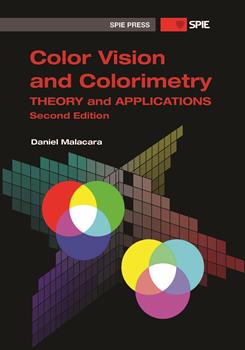|
A small displacement in the CIE color space X, Y, Z will not produce the same change in the perceived color at any point or any direction of change. Similarly, any displacement in the CIE chromaticity diagram will not produce a constant change in hue and saturation. The minimum displacement needed to detect a color change in the CIE diagram is represented by the MacAdam (1942, 1943) ellipses shown in Fig. 6.1, where they are drawn 10 times larger for clarity. We can see that very small changes can be detected near the blue end. On the other hand, purity (saturation) changes in the green region are difficult to detect. Ellipsoids in a 3D space that include small differences in lightness (luminance) have also been obtained by Brown and MacAdam (1949) and by Brown (1957). However, these ellipsoids have been difficult to use, and attempts made to develop algebraic expressions for them have been unsuccessful. Ideally, the CIE color space is modified by means of a linear transformation obtaining a representation on which the minimum perceived color changes in a transparent colored body, or in an opaque colored body, are almost equal at any point and in any direction, which transforms the ellipses into circles with a constant diameter. However, Silverstein (1943) has shown that this transformation is impossible. Several color systems have been designed to obtain an approximately uniform color space. MacAdam (1971, 1974) proposed one system that nearly transformed the ellipses into circles. However, since the transformation is not linear, graphic rules for color addition do not work on this diagram. One other disadvantage is that there is no definite location for the white point. Another provisionally accepted system is the CIE (1960) chromaticity diagram in which the ellipses transform into a system with a smaller range of sizes, as we will see later in this chapter. |
|
|


